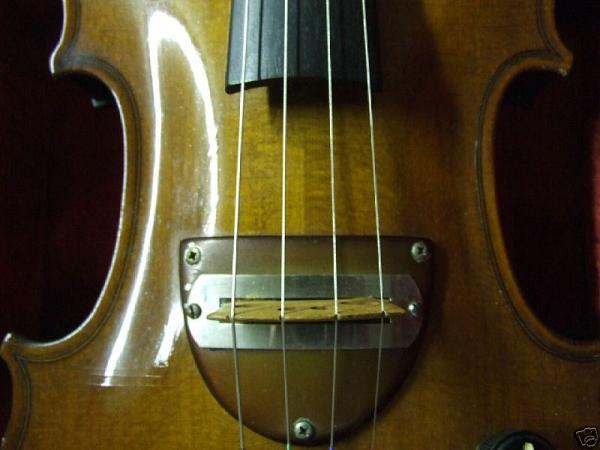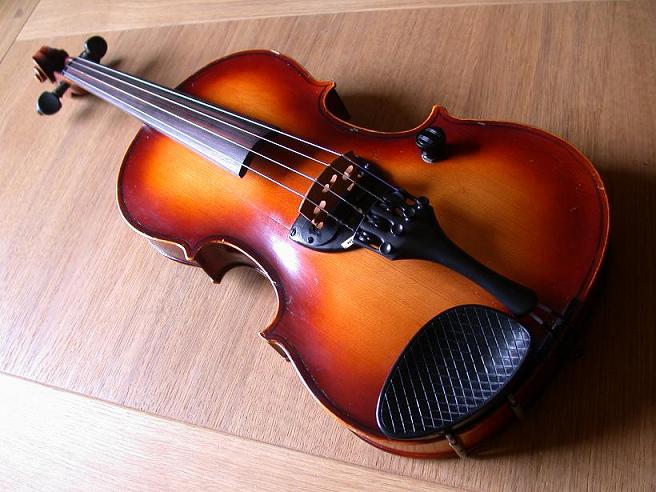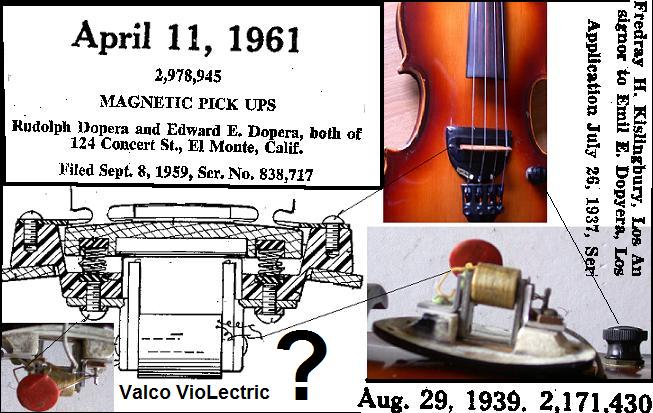Digital Violin
The Violin is Dead

Long Live the Violin
FREDRAY H KISLINGBURY (1937)
There is much as much as nothing known about these violins. At first glance it is America, Chicago violin and as such of interest to collectors. It is completely normal as a shape and the sound is passable as of being a traditional violin to the untrained ear. But this is no ordinary violin - and the instrument photographed below despite striking resemblance to the above is not thought to be by Fredray Kislingbury. There are no "f-holes", two "sound-posts" and a whole load of questions surrounding who really made this violin and when exactly. Contemporary opinion is hard to come by. No-one seems to know anything about them. Mostly, these are instruments virtually unknown to violinists, in general.
The electric violin is discovered as a most simple device here. A coil of wire around magnetic poles; a capacitor; resistor and accompanying wires. This is essentially how Fredray Kislingbury describes a perfected Musical Instrument in his 1937 Patent (see below). But it's an instrument shrouded in confusion ... and if simply a fact that the Valco Company of the 1960s linked to the Dopera name was responsible for this violin, then too it can clearly be understood as a Second Generation Kislingbury. There have been many makers since the the 1960s who have made normal looking violins with pickups in direct or ultimately close contact to the familiar osciallations of the bridge. Fifty years on and traditional electric-acoustic violins are not a surprising find in musical instrument shops.
Electric violins incorporating pickups of this nature first came to public attention through just a few instrument catalogues and other adverts. Maybe broadcasts and recordings had disseminated the sound much further than the pictures of this violin and the maker's name. In all probability too, as many musicians were making music sustained by the rapidly spreading electric music technology. On the whole it just hasn't been recorded as to who was playing what instrument etc. Stuff Smith mostly takes credit where mentioned in adverts but only exacting Artists seem to list the actual make of instrument being played unless of some significance.
National String Instruments Catalogue? 1940?
VIOLECTRIC - THE PERFECT VIOLIN
There are reasons why artists from concert stage to swing band are using and endorsing this fine new violin creation.
"Vio-Lectric" offers for the first time a fine violin with powerful volume, rivaling all modern electronic instruments - including the organ!
"Vio-Lectric" offers pure vibrant rich tones that are absolutely impossible on a regular violin -regardless of price!
"Vio-Lectric" offers to the radio and recording artist a superior and amazing beauty of tone reproduction.
"Vio-Lectric" offers true showmanship, and once again affords the violinist his rightful share of popularity.
"VIO-LECTRIC" BRINGS OUT THE PERFECT REPRODUCTION OF EVERY STRING AND THE TRUE GREATNESS OF EVERY ARTIST!
ARTIST B.C. WRITES " Every time I play my electric violin I receive a new thrill. Tonal qualities and effects are received from the violin which are impossible to receive from a regular violin.... I have astounded my audiences with this unique equipment."
...
FEATURES
"Vio-Lectric" technique is exactly the same as that used on your regular violin.
"Vio-Lectric's" powerful unit weighs only 6oz.
"Vio-Lectric" uses standard violin strings.
"Vio-Lectric" is not a novelty, but a fine violin electrified.
"Vio-Lectric" gives a fullness and depth to any band, and will "fill in the holes" with a glowing rich background.
WRITES CUSTOMER A.H.:
"Believe me, I'll boost the NATIONAL line at every opportunity."
...
"Stuff" Smith - absolute tops in "hot swing fiddle" with his large following of enthusiastic "Rug-Cutters," says...
"THIS VIOLIN IS A KILLER"

The example of the electric violin photographed above looks very similar to the patent drawings and known older photographs of the Naional Dobro electric violin from the early 1940s. The pickup mechanism inside the violin referenced clearly follows the 1961 Dopera patent; however, the external appearance of the violin does not.
Patented Aug. 29, 1939 (2,171,430)
UNITED STATES PATENT OFFICE
MUSICAL INSTRUMENT
Fredray H. Kislingbury, Los Angeles, Calif., assignor to Emil E. Dopyera, Los Angeles, Calif.
Application July 26, 1937, Serial No. 155,665
This invention relates to musical instruments and relates more particularly to stringed musical instruments embodying electro-magnetic pick-up means. A general object of this invention is to provide a practical, effective stringed musical instrument embodying a novel electrical pick-up operable to convert the vibrations of the strings into an electrical current having the characteristics of the vibrations of the strings.
Another object of this invention is to provide a stringed musical instrument of the violin class embodying an electro-magnetic pick-up unit that is operable to produce a varying or modulated electric current suitable for conversion into sound by an amplifying and loud speaker unit that permits the employment of vibratory strings of any character whereby the musician may provide the instrument with gut strings, metal strings, gut strings wound with silk or wire, or any other selected kinds of strings and may tension such strings as desired to obtain tones of the character, timbre and quality desired.
Where I herein employ the term instrument of the violin class I mean instruments such as violins, cellos, violon-cellos, bass viols, guitars, ukeleles, etc.
Another object of this invention is to provide an instrument of the character mentioned in which the electro-magnetic pick-up creates a modulated electric current that may be converted into sound having the timbre, tonal qualities and other characteristics of the tones produced by the conventional instruments of the violin class. The instruments heretofore introduced having electrical pick-up devices have not been capable of faithfully or accurately reproducing violin tones. The instrument of the present invention, on the other hand, is operable to produce tones that are true violin type instrument tones and that are without the metallic sound and harshness found in the tones produced by most electrical musical instruments.
Another object of this invention is to provide an instrument of the character mentioned in which the vibrations of the bass strings, for example the D and G strings of a violin, are given dominance or brought out with greater distinctness than the higher strings or the E and A strings, whereby the desired cello tones may be produced by the musician with ease. In the typical violin and in the usual instrument of this class having an electrical pick-up the E string being of small diameter and under relatively high tension, produces tones that dominate the tones of the heavier strings. In the instrument provided by the present invention this inequality is overcome or lessened to the extent that tones of the heavier strings may be given dominance whereby the instrument is better balanced and easier to play.
Another object of this invention is to provide an instrument of the character mentioned that may be of the same size, shape and appearance as an ordinary violin or violin class instrument and has very little more weight than the average non- electrical instrument, to be handled and played in the same manner as a typical violin type instrument.
Another object of this invention is to provide an instrument of the character mentioned in which the body or sounc� box of the instrument is substantially non-vibratile and incapable of producing vibrations that may affect the electrical pickup means.
Another object of this invention is to provide an electrical stringed instrument of the character mentioned embodying a novel �floating� bridge carried by the diaphragm or armature of the pickup unit.
A further object of this invention is to provide a particularly effective electro-magnetic pick-up unit that is light in weight, small and compact, and adapted to be embodied in a typical stringed instrument with but slight modification of the usual instrument construction.
The improved stringed instrument of the present invention includes, generally, a body, a plurality of tensioned vibratile strings carried by the body, and an electrical magnetic pick-up on the body carrying a floating bridge which engages the strings between their ends. The body of the musical instrument may be of the same size, shape and construction as the body of an ordinary instrument or typical stringed instrument. For example, where the invention is embodied in a violin � the body may be constructed of wood and may have the same shape as the body of a conventional violin. If desired the pick-.up may be applied to or embodied in the body of a typical violin which has been modified to make it substantially non-vibratile. In accordance with the broader aspects of the invention the instrument body may be made substantially non-vibratile and non-resonant in any suitable manner. In practice it has been found desirable to provide a plurality of spaced braces or posts 4 in the interior of the hollow body S to connect its upper normally vibratile wall with the �bottom of the body to make the upper wall substantially rigid and non-vibratile. The posts are rigidly secured to the top wall and are effective in preventing vibration of the same. The usual openings in the upper body wall may be closed with fabric or the like, to-further dampen the body. In addition to the posts and the fabric, the body may be lined or filled with felt, kapok or the like to lessen or prevent vibration of the body or the resonance of the body. The body is provided with the usual neck. The neck is rigid with the body and projects outwardly from the body. The conventional finger-board is provided on the neck and the outer portion of the neck carries the string tensioning pegs .
The strings are stretched across the upper face of the body and the fingerboard and constitute the vibratile elements or sound propagating elements of the instrument. In the case illustrated there are four spaced strings which may be considered as the conventional E, A, D and G strings of the violin. The strings are tensioned between a tail piece on the body and the pegs at the outer end of the neck. The pegs may be employed to tension and tune the strings in the usual manner. It is a feature of the invention that the strings may be of any desired or selected character. For example, the strings may be metal strings, gut- strings, gut string wound with silk or metal, and the different strings may be of different materials and construction. In accordance with the usual practice the strings are graduated in diameter. While the strings may be tuned differently I will herein designate them as the E, A, D and G strings, the E string being the smallest in diameter and the G string being the largest in diameter.
The pick-up is provided to convert the vibrations of the strings or vibrations produced by the strings into a modulated electric current which in turn may be reproduced as sound truly representative of the tone producing vibrations of the strings. It is a fevention that the pick-up is small, light in weight, and readily arranged on the body of the musical instrument.
...


This work is licensed under a Creative Commons Attribution-NonCommercial-NoDerivs 2.5 License.
up




